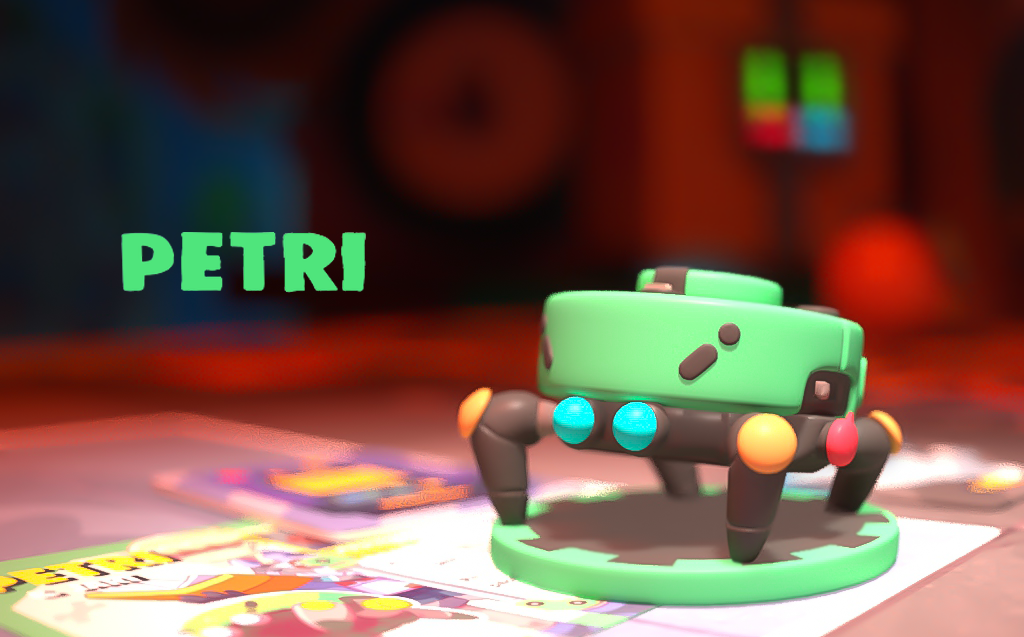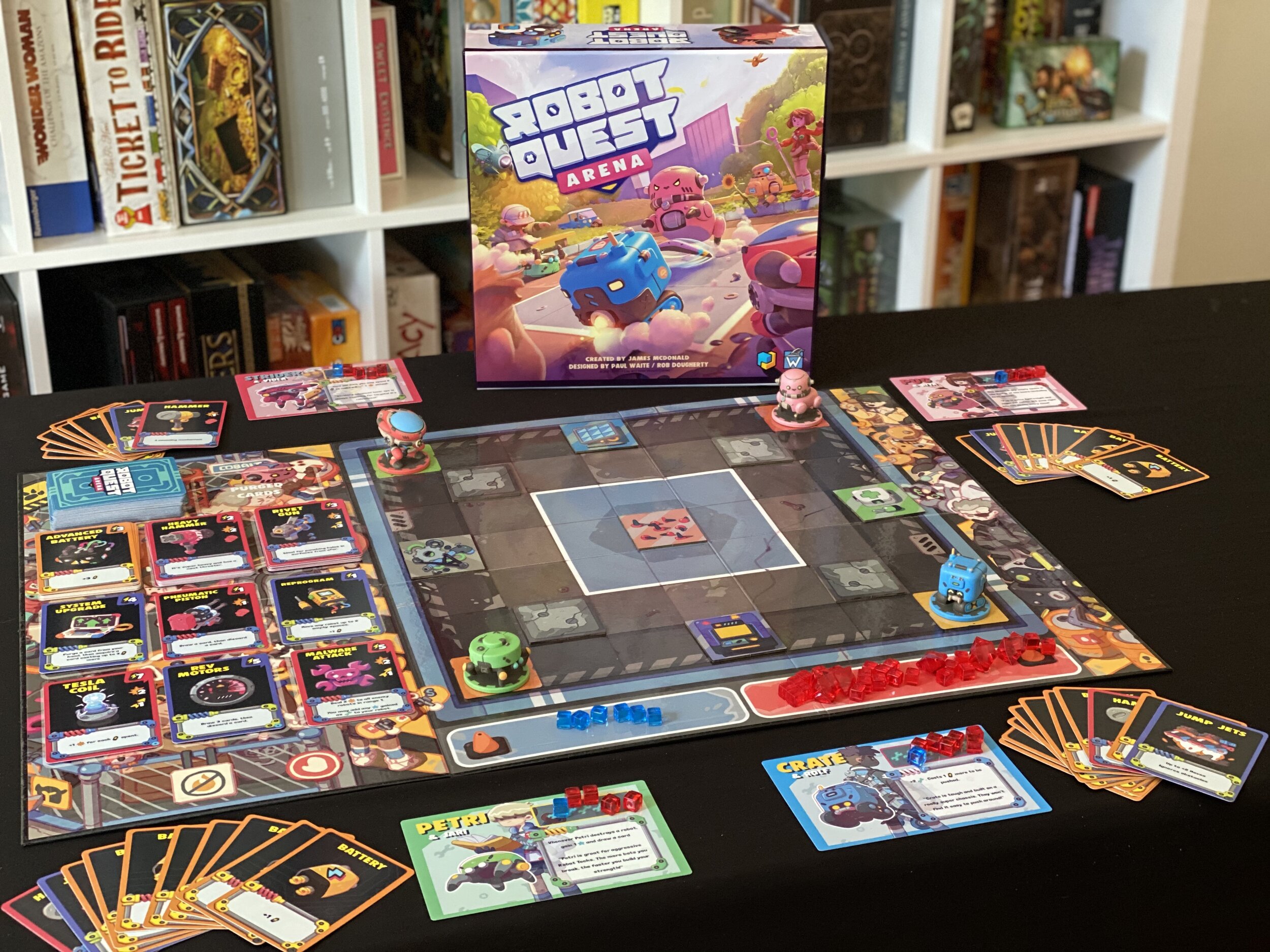Robot Quest Arena – First Impressions
With two weeks left in the Robot Quest Arena Kickstarter campaign, I figured that it was time to talk about this rowdy box of bolts that surprised me quite a bit. After a long weekend of gaming and little sleep, this arena skirmish game did not strike me as something I’d grab off the shelf. When you get into it, though, it’s a heavy-metal (literally) cross between the art design of games like Overwatch and the brawl-fest of TV shows like Robot Wars.
It’s a skirmish game with deckbuilding. It’s an arena brawler with cute robots. It’s a family game with a potential for solid variability. And it’s a fun-filled bout at that.
Put your bets in because this one could take the win. Designed by Paul Waite and published by Perfect Day Games and Wise Wizard Games, it’s a board game for 2-4 players where players assume control of a robot and their human teammate(s). Think Pokémon but with pug- and insectoid-shaped robots. Then, through tactical deck-building and battlefield awareness, one robot will emerge victorious while the others lay broken in heaps of rivets, puddles of plasma, and piles of severed servos.
Think you have what it takes?
What It Does
In an alternate universe where Pikachu isn’t the king of cute or the queen of combat is a little city named Rivet. It’s got districts like Zootopia, but unlike that utopian animal city, Rivet is a place of Robot Techs. Ground-and-pound is the name of the game over here and if you thought human wrestling was a highly watchable sport then just wait until you see hydraulic pistons, sophisticated robotics, and big metal chassis going (metal) toe-to-toe.
If you’re going to be the best Robot Tech, though, you need to know what to do. And, thankfully, it’s rather straightforward.
Take a robot. Read about their unique ability. Grab a starting hand of cards. Jump in the arena. And start battling.
That’s mostly what you need to know about Robot Quest Arena. There isn’t a rules reference and a learn-to-play booklet and an errata and a 10-page long tutorial. It’s a dogpile (pugpile?) of robots who are banging and smacking and whacking each other while wheeling and scooting and jumping around.
You can play five cards each turn. Use energy to move around the arena and buy new cards. Attack other robots with the base and upgraded cards in your hand. Stay alive as long as you can before needing to respawn. You get points for the damage that you do to other bots so get in the fray and start getting slappy happy.
If you give more than you get, you’ll have a good chance of stepping away from the arena as the best bot in Rivet.
How It Does It
Let’s get technical! Technical!
Two major mechanisms are at play in a game of Robot Quest Arena. Deck-building and small-scale skirmish combat. Smaller elements work in the background, but those are the two components at the forefront of the gameplay experience.
Players will draw five cards from their hand (which starts at 10 cards) and use those cards to buy new ones, move around the arena, and attack other robots. The starting hand and upgraded cards that can be acquired from the market make up the deckbuilding half.
Then there is the more violent half. A half in which you tear your enemies into quarters. And then grind those quarters into small pieces.
Combat in Robot Quest Arena is frantic yet forgiving. There is no player elimination. Robots simply respawn whenever their health is fully depleted. But respawning takes cubes from the central supply which dwindles over the course of the game. And the damage that a robot receives is awarded to the attacking robot. That’s where the points originate in the game. Hit the other robots and take their broken plates and scraps as trophies!
The two secondary mechanisms that players will need to consider are the robot’s variable powers and the arena tiles that are used. Each robot has a distinct ability that informs its style of play. Crate is harder to push and kill. Pug can spawn in multiple spots in the arena. And then Strider and Petri also have special skills that may influence what type of cards you want to integrate into your deck.
Where the magic in Robot Quest Arena resides is in the swirling mix at the center of those four design pillars.
It’s easy to understand but exciting to explore.
Why You Might Like It
The deckbuilding is light but rewarding with a lot of different melee and ranged pathways that players can explore, as well as energy and hand increases to extend the life of your turn.
The visual style of Robot Quest Arena is inviting to players of all ages and the gameplay can act as an entryway to more complex titles within the dual genres of skirmish games and deckbuilding games.
Why You Might Not
While there are many winning combinations that can be crafted in the deckbuilding process, some players may be frustrated by card powers that can be manipulated to enable instant KOs.
With expansions and additional robots, the increased variability could easily keep many players engaged over multiple plays, but the base box alone might not be enough for those wanting a deep, iterative skirmish game.
Final Thoughts
I like this game. More than I thought I would.
At first, I was a little taken aback by my reaction to Robot Quest Arena. Part of my childhood in England was spent watching Robot Wars and this experience hearkens back to those days of bots crashing into each other while their teams cheered on from the sidelines. But nostalgia isn’t the main driving force behind my interest. And, yes, I’m also looking for more games to play with my son now that he’s old enough, but that’s not fully it either. There is purity to the fun of this game. It’s quirky. Its techie. It’s a family-friendly deckbuilder with some in-your-face fighting.
The variable powers of the bots are interesting. Some light asymmetry there. The interchangeable arena locations lend an extra layer of strategy or tactical planning to each fight. And the combos that you can create with the open market provide a satisfying deck-building experience.
I’m curious how the game will feel after 5-10 plays, but I like what I saw and I think the three additional robots, Kickstarter promo cards, and other content that has been revealed will make this a stronger game overall. Hopefully, content is planned outside of Kickstarter exclusives, but I imagine it will be.
For many gamers, I think this will be a fun experience. You don’t have to have kids. You don’t have to love deckbuilding games. In the two games of Robot Quest Arena that I played, we just enjoyed the chaos and embraced the silliness of the mechanized mayhem.
If you want to check out Robot Quest Arena, you can visit the Kickstarter campaign or read what the community thinks on BoardGameGeek.
Are you thinking of backing Robot Quest Arena? What’s your favorite arena skirmish game?
Let us know in the comments and give a recommendation for other games of which to share our first impressions.






